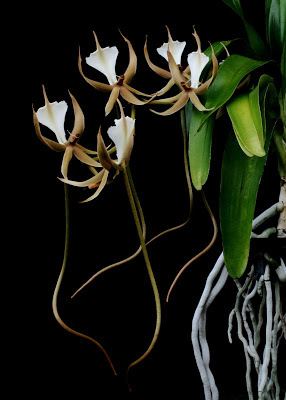Plectrelminthus caudatus was at one time also called Angrcaecum caudatum, however it is still part of the Angcraecum alliance. It is the only species in the genus. It's origin is West Africa; from Guinea east to the Congo. Grows at low altitudes on thick tree trunks, heavy branches and large rocks in leaf matter. It's Latin translation is the twisted one or long like a worm (referring to the long twisted nectary or spur). It is the only Angcm. that I personally grow more like a vanda than any other Angcm. in my collection. I do have one growing in a clay pot but it seems very dwarfed in comparison to the plant growing open rooted in a plastic basket.
As I talk in my Angcracum lecture, I mention that the main similarity to the Vandeae tribe is that the Angcraecum genera are single stem, non-psuedo bulb plants with alternating leaves. It very much looks like a vanda although it's leaves are broader, slightly folded through the center and bilobed at the ends. You start to get the sense of a difference when the plant begins to show signs of blooming. The inflorescence doesn't grow straight; it zig-zags at each bract (as you can see with the added white lines in Plmths. caudatus #2). And there is a reason for this.
As the buds begin to develop, they start to twist so that they are facing slightly in (not out as a traditional vanda may). They are already in an upright position so that the nectary will drop down; as shown in the image below (Plmths. caudatus #3).

I said earlier that I grow Plmths. caudatus like a vanda, hanging bare rooted in plastic basket. Keep in mind that it is from the Angcraecum alliance, therefore, "DON'T MESS WITH THE ROOTS"! The roots will grow as the vanda's do. Many growers have a tendency to cut the roots of their vandas during the cooler months. DO NOT CUT THE ROOTS, it is not a vanda! Once the roots have been cut, the plant will continue to grow but the plant will not bloom for 2 - 5 years.
The amount of light that you should allow the plant to receive can vary from very bright shade to morning direct sun light with spackled bright light throughout the remainder of the day. With a new plant, you should watch your plant carefully, making sure that the leaves don't burn. Mid day and late afternoon direct sunlight can and will eventually burn the leaves.
During the warm summer months, I water the bare rooted plants every morning and will very often mist them in the late afternoon. I try not to get to much water on the plant's leaves to prevent the water from sitting there to long. Water that sits in the leaves near the stem can cause problems and the plant usually will not survive (stem rot). Keep the plant in an area with a good cross breeze and the excess water does evaporate/dry up quick enough throughout the day and prevents this problem.
When the cooler months take over, I back off the watering to every 2 - 3 days; depending on the air temperatures. Cooler temps, less water. If night time temps drop below 50 degrees for more than a couple of days, I will either cover the plants or move them inside. If temps are going to be below 45 degrees, cover them or move them. Remember, Plmths. caudatus is a sub-tropical plant.
I fertilize my plants once a week. I use a systemic fungicide every 3 - 5 weeks and as always, keep a quart spray bottle of a topical fungicide on hand for just about any emergency regarding fungus.
 In the northern hemisphere, it will usually flower in early fall to spring. Once the plant is fairly well established, it will start to bloom just about anytime of the year; with more flowers appearing during it's regular blooming season.
In the northern hemisphere, it will usually flower in early fall to spring. Once the plant is fairly well established, it will start to bloom just about anytime of the year; with more flowers appearing during it's regular blooming season.
The inflorescence is horizontal as stated earlier but can become pendant like. It will contain 6 - 18 flowers. Flowers are about 2 3/4 inches wide (7cm) and 3 inches high (9cm). The nectary can be up to 10 inches long (25cm) and is twisted.
Plmths. caudatus will grow in cooler climates, even those with cold winters. However, the plant should be grown inside where it will get morning sunlight. A warm greenhouse would be perfect. In a home, it can be placed on a table or hanging in the window that faces east so that it will get that morning sunlight. Moving the plant outside in the warm summer months underneath a tree or hanging in the tree so that it will get bright spackled light throughout the day. Watering conditions will be slightly different, not near as much as if it were in a sub-tropical climate.
